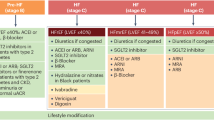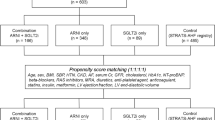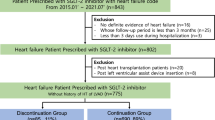Abstract
Sodium glucose co-transporter-2 inhibitors (SGLT2i) and the non-steroidal mineralocorticoid receptor antagonist (nsMRA) finerenone have each been shown to individually improve heart failure events among patients with heart failure and mildly reduced or preserved ejection fraction (HFmrEF/HFpEF). Moreover, the angiotensin receptor neprilysin inhibitor (ARNI) sacubitril/valsartan has been shown to improve outcomes in patients with HFmrEF/HFpEF with a left ventricular ejection fraction (LVEF) below normal (<60%). However, the expected benefits of the combined use of these agents with long-term administration are not well defined. In this cross-trial analysis of DELIVER, FINEARTS-HF, and PARAGON-HF, combined use of SGLT2i and nsMRA therapies was estimated to reduce the risk of cardiovascular death or first worsening HF event by 31% in the overall population (HR 0.69; 95% CI 0.59 to 0.81), while combined use of SGLT2i, nsMRA, and ARNI therapies was estimated to reduce risk by 39% in patients with HFmrEF/HFpEF and an LVEF<60% (HR 0.61; 95% CI 0.48 to 0.77). With long-term use, combined SGLT2i and nsMRA therapies in a 65-year-old patient with HFmrEF/HFpEF, or combined SGLT2i, nsMRA, and ARNI therapies in a 65-year-old patient with an LVEF<60%, were projected to afford 3.6 (2.0 to 5.2) or 4.9 (2.6 to 7.3) additional years free from cardiovascular death or a HF event, respectively. Combined therapy was estimated to result in meaningful gains in event-free survival across a broad age range from 55 to 85 years. Among patients with HFmrEF and HFpEF, the potential aggregated long-term treatment effects of early combination medical therapy with SGLT2i and nsMRA (and ARNI in selected individuals) are projected to be substantial.
This is a preview of subscription content, access via your institution
Access options
Access Nature and 54 other Nature Portfolio journals
Get Nature+, our best-value online-access subscription
$32.99 / 30 days
cancel any time
Subscribe to this journal
Receive 12 print issues and online access
$259.00 per year
only $21.58 per issue
Rent or buy this article
Prices vary by article type
from$1.95
to$39.95
Prices may be subject to local taxes which are calculated during checkout
Similar content being viewed by others
Author information
Authors and Affiliations
Corresponding author
Supplementary information
Rights and permissions
About this article
Cite this article
Vaduganathan, M., Claggett, B.L., Chatur, S. et al. Lifetime Benefits of Comprehensive Medical Therapy in Heart Failure with Mildly Reduced or Preserved Ejection Fraction. Nat Med (2025). https://doi.org/10.1038/s41591-025-04037-3
Received:
Accepted:
Published:
DOI: https://doi.org/10.1038/s41591-025-04037-3



